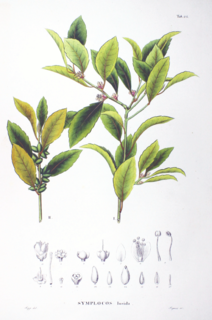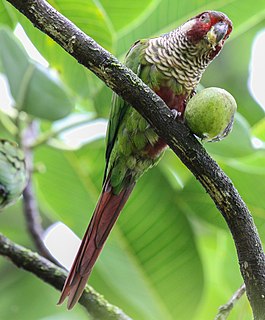
Symplocos is a genus of flowering plants in the order Ericales. It contains about 300 species distributed in Asia and the Americas. Many species grow in humid tropical regions. This is sometimes considered to be the only genus in family Symplocaceae. Plants in this family are shrubs and trees with white or yellow flowers.

The painted parakeet, more commonly known as the painted conure in aviculture, is a species of bird in the family Psittacidae, the true parrots. Its taxonomy is highly complex, and has undergone significant changes in recent years. As here defined, it is restricted to forests in northern South America and Panama. Some of the taxa here included in the painted parakeet are highly endangered.
Symplocos badia is a species of plant in the family Symplocaceae. It is endemic to Ecuador. Its natural habitat is subtropical or tropical moist montane forest.
Symplocos barberi is a species of plant in the family Symplocaceae. It is endemic to India.
Symplocos blancae is a species of plant in the family Symplocaceae. It is endemic to Ecuador. Its natural habitat is subtropical or tropical moist montane forest.
Symplocos canescens is a species of plant in the family Symplocaceae. It is endemic to Ecuador. Its natural habitat is subtropical or tropical moist montane forest.
Symplocos carmencitae is a species of plant in the family Symplocaceae. It is endemic to Ecuador. Its natural habitat is subtropical or tropical moist montane forest.
Symplocos chloroleuca is a species of plant in the family Symplocaceae. It is endemic to Ecuador. Its natural habitat is subtropical or tropical moist montane forest.
Symplocos clethrifolia is a species of plant in the family Symplocaceae. It is endemic to Ecuador. Its natural habitat is subtropical or tropical moist montane forest.
Symplocos cordifolia is a species of plant in the family Symplocaceae. It is endemic to Sri Lanka.
Symplocos fuscata is a species of plant in the family Symplocaceae. It is endemic to Ecuador. Its natural habitat is subtropical or tropical moist montane forest.
Symplocos globosa is a species of plant in the family Symplocaceae. It is endemic to Ecuador. Its natural habitat is subtropical or tropical moist montane forest.
Symplocos hispidula is a species of plant in the family Symplocaceae. It is endemic to Sri Lanka.
Symplocos nivea is a species of plant in the family Symplocaceae. It is a tree endemic to Peninsular Malaysia. It is threatened by habitat loss.
Symplocos pluribracteata is a species of plant in the family Symplocaceae. It is endemic to Ecuador. Its natural habitat is subtropical or tropical dry shrubland.
Symplocos rimbachii is a species of plant in the family Symplocaceae. It is endemic to Ecuador. Its natural habitat is subtropical or tropical moist montane forest.
Symplocos truncata is a species of plant in the family Symplocaceae. It is endemic to Ecuador. Its natural habitat is subtropical or tropical moist montane forest.
Symplocos verrucisurcula is a species of plant in the family Symplocaceae. It is endemic to Ecuador. Its natural habitat is subtropical or tropical moist montane forest.
Symplocos anomala is a plant in the family Symplocaceae.
The Sinú parakeet is a species of parrot in the family Psittacidae. It is only known with certainty from the Sinú Valley in northern Colombia. BirdLife International estimates that if the bird is not already extinct, no more than 50 likely exist. Despite extensive searches, there have been no confirmed records of the parakeet since 1949. Scientists know very little about the Sinú parakeet's reproductive physiology, nutritional needs, ecology, or behavior. There are 18 specimens known from four locations in Colombia, two of which have been deforested. The parakeet is among the 25 “most wanted lost” species that are the focus of Global Wildlife Conservation's “Search for Lost Species” initiative.


